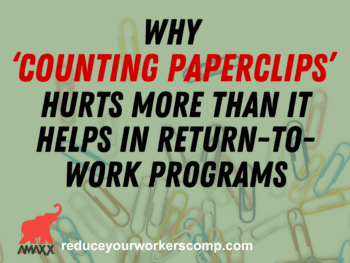One of the easiest ways to cut workers comp disability losses is to offer light duty employment, says workers’ comp authority Attorney Brad Bleakney of the Chicago firm Bleakney & Troiani. There are several things that should be kept in mind with an offer of transitional light duty employment:
Click Link to Access Free PDF Download
“13 Research Studies to Prove Value of Return-to-Work Program & Gain Stakeholder Buy-In”
1. Provide documentation with a letter stating temporary restricted work is available while a worker is recovering from a work-related injury/illness.
2. Include details on Where, When and to Whom to report to for the position
4. Include a general description or title for the position
5. Explain that this is a temporary position and that permanent placement will be reviewed as soon as restrictions are permanent or medical care ends.
6. Make it clear that a return to their former position is dependant on the availability of positions at the time of medical discharge and depends upon whether they can perform essential job functions given the permanent restrictions, if any.
7. Add a Signature Line or Check box for the worker to acknowledge the offer and either Accept or Reject the light duty employment and date it.
FREE DOWNLOAD: “13 Research Studies to Prove Value of Return-to-Work Program & Gain Stakeholder Buy-In”
When the restrictions become permanent and as positions are available, make every effort to move the worker into a permanent position. This is the best possible evidence of a resumed earning capacity. If an economic layoff should later be necessary, the lack of work can be said to be economic related and not due to medical restrictions from the injury.
In Illinois, as long as an injured worker remains under active medical care with temporary restrictions, the employer’s failure to provide work within the restrictions will result in liability for ongoing payment of temporary disability payments.
When an injured worker has been given permanent restrictions and is given a permanent job placement, the employer is relieved from any vocational rehabilitation costs, “maintenance” disability payments, wage supplement claims or permanent total disability pensions. If a layoff should occur after permanent placement, the burden shifts to the injured worker to try to prove the lack of employment is due to the restrictions rather than the economy.
Remember, a permanent job position avoids the biggest settlements for wage loss claims and permanent total disability claims which cost the employers the most money and create the biggest attorney’s fees. Cut your workers comp costs with an effective return to work program.
Brad Bleakney of Bleakney & Troiani in Chicago, IL practices in the areas of work-related injury claims third party litigation for accidental work injuries. He has a background in industry where he helped a Fortune 500 company reduce their workers’ compensation losses significantly. Brad can be reached at: Brad Bleakney, Bleakney & Troiani, 1 North Franklin (2625) Chicago, IL 60606 312-541-0045 or fax 312-541-0041 info@WorkComp-Chicago.com
Try the WC Cost Calculator to show the REAL COST of work comp.
Look at WC 101 for the basics about workers comp.
Do not use this information without independent verification. All state laws are different. Consult with your corporate legal counsel before implementing any cost containment programs.
©2008 Amaxx Risk Solutions, Inc. All rights reserved under International Copyright Law.















